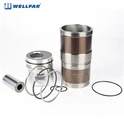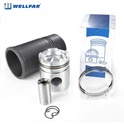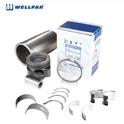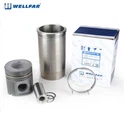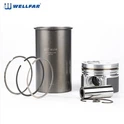Most of the cylinder liners are iron casting because the presence of graphite which acts as a lubricant. Cast iron is also porous and provides excellent damping properties. The majority of the cylinder liners are manufactured by centrifugal casting while some are gravity casting.

The material used for making cylinder liners must serve multiple purposes and cast iron itself cannot fulfill all of the function, so some micro elements will be added into cast iron, these additives are:
Chromium: to improves the hardness and wear resistance of the liner. Chromium is also a corrosion-resistant metal that increases the corrosion resisting capacity.
Molybdenum: to increase the wear resistance and liner strength, also to offer resistance against high temperature and pressure.
Nickel: added in small quantities to improve the machinability, to provide uniform strength throughout the casting volume.
Copper: to improve the pearlite structure of cast iron, to reduce the friction coefficient and provides an excellent sliding surface, to improve the corrosion resistance of the liner.
Vanadium: to improve the metallic structure of the liner and increases the hardness and makes the liner less fragile.
Titanium: as it reacts with nitrogen to form titanium nitride. It reduces the formation of compact graphite structures and also reduces the blow holes.
Phosphorus: to improve the grain structure of cast iron.
Silicon: to reduce the shrinkage of the liner and strengthens the structure.


